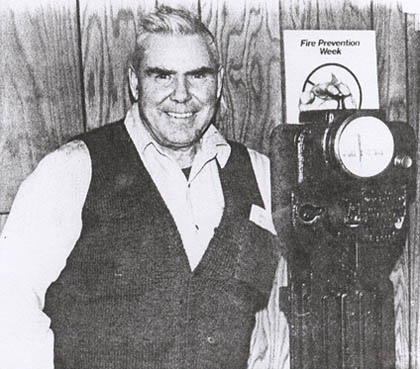
Public Relations and Advertising
Department
Windsor Station Montreal Que. H3C 3E4
|
Volume
11 Number 4
|
March 25,
1981
|
Antique Signal System Served
Line Well
By Pat Johnson

Obsolete system:
Thirty-three-year veteran Jim Styles is seen here with the last
operating electric staff system in North America.
Sudbury - Say goodbye to the
last operating electric staff system in north America. For over 68 years, the brass
plated signal system has been controlling train access to the shared Canadian Pacific
and Canadian National rail lines at Clarabelle Junction.
"It's going to be retired", says Stewart Law, CP Rail's signal supervisor
here. "We've all but run out of parts to repair it... The next time it breaks
down, that's it".
As one of the first signal systems ever to be installed, it will probably end up in a
railway museum along with other obsolete machinery and old photos.
It's a rather sad fate for the noisy antique. It still works fine; but Jim Styles, a
33-year CP Rail employee who is now an operator at Clarabelle Station,
points out a major problem - the machine has been obsolete since it was purchased in
1912. This was discovered in 1930 when previous operators sent for new parts from the
Liverpool manufacturer.
Despite this drawback, Mr. Law says it is most likely still being used in parts of
Africa since it is a reliable forerunner of modern rail "traffic lights".
The electric staff system at Clarabelle controls a single section of track which is
shared by the two national railways. A primitive form of traffic light, it informs
engineers whether it is safe to proceed along the track or whether a train is already
occupying the stretch.
INNER WORKINGS
The system consists of two parts. One machine, which resembles a small grandfather
clock, is housed inside the station along with a generator. The other is located at
the head of the junction. They operate through a series of brass and iron weights
called "staves". When a train reaches the head of the junction and wishes
to proceed to the station, a button is pushed at that end of the system. The button
activates a bell in the station. This lets the operator know that a train is waiting
to come into the junction. If a train is not already occupying the stretch, the
operator will crank a generator to provide power to the electric staff system at the
junction. The power loosens the machine's "grip" and a trainman is able to
remove one of the staves.
Once a staff (the singular form of stave) is removed, the machine's dial will
indicate that the rail line is blocked. If another train approaches the line, the
engineer knows it is unsafe by reading the dial on the machine.
Once the staff is removed, it is placed in a leather pouch and kept on board the
train until it leaves the junction. At that time, the staff is replaced in the
machine and the dial turns to "staff in - (line) clear". The staves can
also be removed or replaced at the station, since the machines are interconnectable.
Mr. Law expects that when the device is finally retired, engineers will receive radio
permission to enter the junction. Other systems have been replaced by lights.
It will be a melancholy day when the staff system is banished to a museum. "A lot
of people are going to miss it", Mr. Law admits. "We've been pretty proud of
the old thing. It's not very often the younger generation get to work on something
that still works the way it's supposed to... and it's still shiny as can be
inside".
So long, oldtimer.
This CP Rail News article is
copyright 1981 by Canadian Pacific Railway and is reprinted here with their
permission. All photographs, logos, and trademarks are the property of the Canadian
Pacific Railway Company.
|